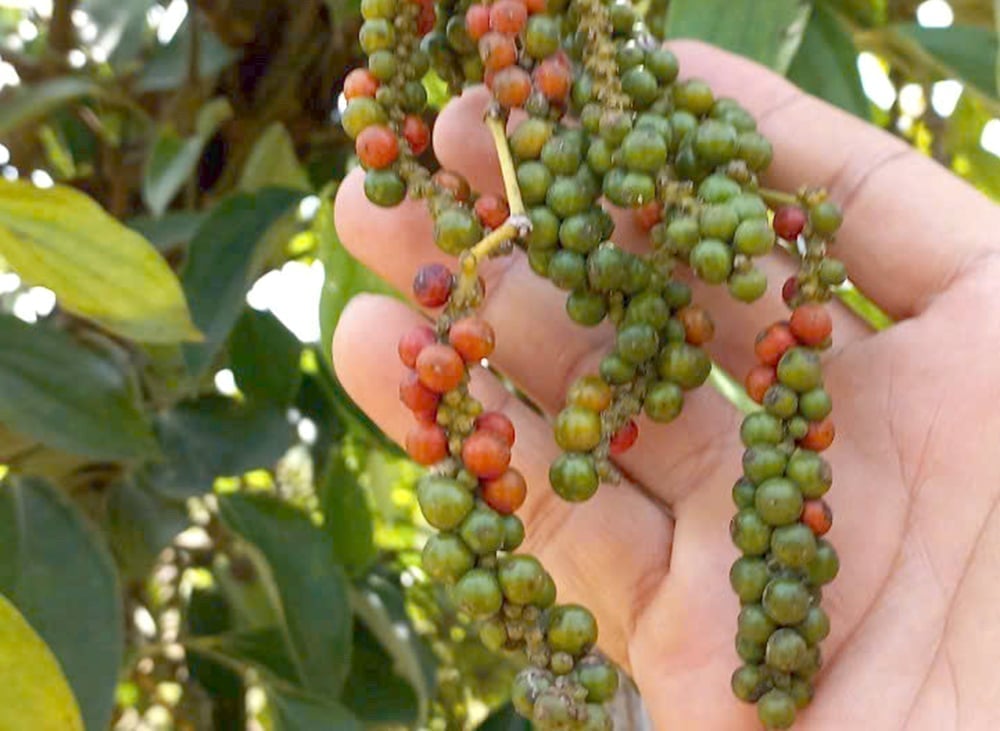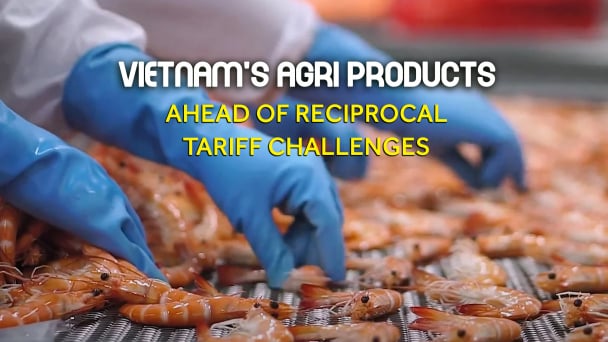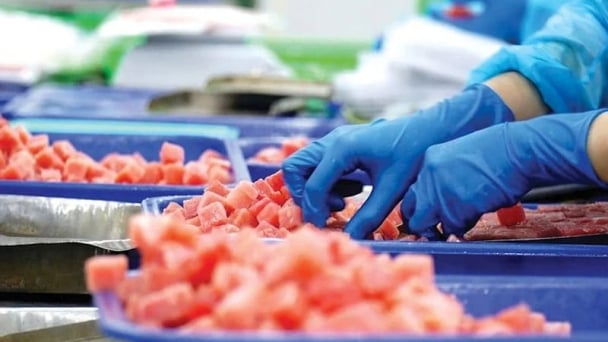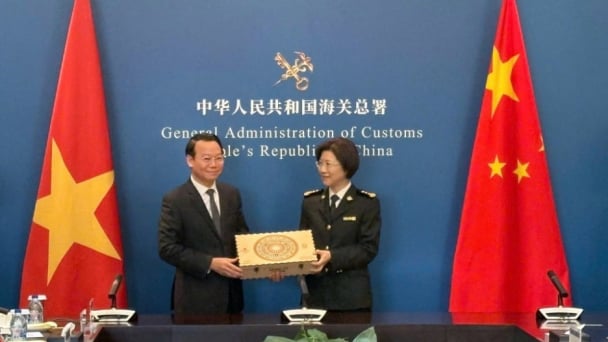May 30, 2025 | 17:20 GMT +7
May 30, 2025 | 17:20 GMT +7
Hotline: 0913.378.918
May 30, 2025 | 17:20 GMT +7
Hotline: 0913.378.918

Vietnam's pepper production may decrease this year. Photo: Son Trang.
In the first quarter of this year, Vietnam's pepper exports decreased in volume but increased significantly in value. According to the Vietnam Pepper and Spice Association (VPSA), pepper exports in the first quarter reached 47,660 tons, valued at 327 million USD, a 16% decrease in volume, but a 39% increase in value.
Vietnam's pepper production may continue to decrease this year. The prolonged drought during the first months of 2025 has significantly affected pepper production in the Central Highlands and Southeast regions. A few rain showers in some areas have helped relieve the drought for some pepper gardens, but for those already harvested, it will affect the flower bud differentiation, leading to a potential decrease in pepper yield next year.
Despite the decrease in production, pepper farmers are confident about prices. Currently, Vietnam's pepper harvest is at its peak and is expected to last until the end of April 2025. In previous years, during the harvest season, pepper prices often decreased due to abundant supply. However, this year, even during the harvest period, domestic pepper prices remain around 150,000 VND per kilogram because farmers are selling cautiously, not under financial pressure.
Earlier this April, after the U.S. government announced reciprocal tariffs on its trade partners, pepper prices dropped significantly. However, as soon as the U.S. decided to postpone the tariffs for 90 days, the market saw a rebound, with pepper prices quickly rising back up and approaching 160,000 VND per kilogram by mid-April.
Looking ahead to pepper exports in the second quarter and beyond, VPSA forecasts several challenges for the pepper export sector. The current high prices of pepper are putting pressure on both exporters and importers, creating financial difficulties. The uncertainty surrounding the potential changes in U.S. tax policies also adds to the complexity of the situation. Many importers remain cautious about making long-term contracts at this time. This could result in limited orders in the coming months.
Ms. Hoang Thi Lien, President of VPSA, mentioned that while some U.S. importers are prepared to accept the additional 10% tariff imposed on goods from all countries, others remain hesitant and are not yet willing to pay this extra charge for Vietnamese pepper shipments.

A pepper garden in Binh Phuoc. Photo: Son Trang.
According to Ms. Hoang Thi Lien, if the U.S. maintains its reciprocal taxes on Vietnamese pepper after the 90-day postponement period, Vietnamese pepper will face significant disadvantages in the U.S. market compared to competitors such as Brazil, India, and Indonesia. These countries are subject to much lower reciprocal tariffs - or, in Brazil’s case, not subject to any retaliatory tariffs at all.
The Vietnam Pepper and Spice Association also emphasized that the current international trade environment is evolving rapidly and unpredictably, especially as the U.S. continues to implement tariff policies on a wide range of countries, including Vietnam.
Therefore, to proactively adapt to the changing global trade landscape and to protect Vietnam’s long-term trade interests while ensuring that domestic production and export activities are not disrupted—Vietnamese pepper businesses need to formulate strategic plans that are responsive to the new situation. This includes seeking customers and partners in import markets that still have ample room and potential for development and exploitation.
Enterprises should also pay close attention to selecting and managing sources of raw pepper used in the production of export goods. It is essential to ensure that these raw materials meet the requirements set by importers, especially in terms of product traceability and the certification of origin for exported goods.
In order to sustain export volumes and remain competitive, Vietnamese pepper enterprises are encouraged to intensify their export efforts to alternative markets such as the European Union, India, and the Middle East. Furthermore, it is vital for businesses in the pepper industry to increase investment in deep processing technologies and in building strong, recognizable brands.
Ms. Hoang Thi Lien emphasized that Vietnamese enterprises exporting pepper to the U.S. must adopt a proactive and forward-thinking approach. Rather than waiting for the 90-day review period to end and relying on the outcome of the final retaliatory tariff decision, companies should begin preparing alternative strategies and identifying new export markets. This is particularly important in the event that the final tariff imposed by the United States is unfavorable to Vietnam’s pepper exports.
According to VPSA, Vietnam’s pepper exports to China in the first quarter of this year increased sharply compared to the same period in 2024. This indicates that China’s pepper reserves have fallen to a low level.
However, at present, pepper exports to China are still limited due to the tightened control on border trade by Chinese Customs. Meanwhile, exporting pepper to China by sea would result in much higher costs, so Chinese importers are still not ready to switch to this method.
$ 1 = VND 25.690 - Source: Vietcombank.
Translated by Phuong Linh

(VAN) Reciprocal tariffs are exerting pressure on U.S. exports, prompting Vietnamese firms to shift their focus to Muslim markets, Thailand, and Brazil.

(VAN) A free booth for two years at Xinfadi, Beijing's largest wholesale market, will be allocated to Vietnam's agricultural products.

(VAN) Vietnamese shrimp exporters are actively looking for alternative markets and accelerating shipments to the United States in response to the pressure of impending reciprocal tariffs. This is occurring during a temporary tariff suspension.

(VAN) The import-export turnover between Vietnam and Singapore rose amid a trade rebound, with machinery, electrical equipment, and fuels making up the majority of the transaction value.

(VAN) Director General of the General Administration of Customs of China, Ms. Sun Mai Jun, has pledged to implement measures that will ease the import process for Vietnamese agricultural products.

(VAN) Although Vietnam is still increasing its coffee exports, the industry is currently in the process of determining market strategies in response to the U.S. imposition of reciprocal tariffs.

(VAN) With rising demand in Muslim-majority countries, Halal certification is becoming a critical passport for Vietnamese agricultural products seeking sustainable market access and consumer trust in the Middle East and Africa.